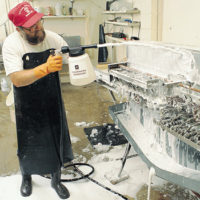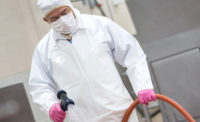The emergence of foodborne pathogens such as Listeria monocytogenes, Salmonella, Escherichia coli O157:H7 and Campylobacter have grabbed national media attention and awareness. In the heavily regulated food processing industry, poor sanitation is not only a problem for public safety but can represent significant costs for those hit with an outbreak. “We’ve all heard the saying that ‘the little things can cause the biggest problems’,” says Chris Celusta, manager, food processing sanitation, with Spartan Chemical Co., Inc. of Maumee, OH, a recognized international leader in the manufacture of chemical specialty and industrial maintenance products since 1956. That theory applies to sanitation within the food plants. Simple mistakes can have costly consequences, but the reality is, if a plant takes the time to address sanitation needs upfront, most common mistakes are easy to fix.
Proactive Ways to Avoid Sanitation Mistakes
Celusta and his team of experts at Spartan compiled this list of the areas in a sanitation program where the top six most common mistakes occur and how to fix them.
Employee training. Training should focus on the fundamentals of sanitation, food microbiology and the role of employees in maintaining food safety of food products. Work with your vendor to find the best training programs on personnel hygiene, personal protection equipment (PPE), proper sanitation chemical handling and effective cleaning procedures. New regulations from the Occupational Safety and Health Administration in 2015 require a whole new labeling and safety information system. Be sure that you are partnered with a chemical manufacturer that can assure your compliance with the Globally Harmonized System for Classification and Labelling of Chemicals. In summary, a good training program frees up productivity so your staff can be most effective doing their job in the limited time available.
Personnel hygiene. How often do you explain when, where and how to wash your hands to your employees? Do you emphasize the importance of taking showers, checking for cuts, wearing clean clothes, pulling back long hair and removing jewelry? Many people do not realize that the cracks in their hands and fingernails can be excellent carriers for those bad bugs. Simple reminders for employees to regularly and consistently wash their hands are equally important.
Sanitation product labeling. As much as processors try to “color code” their programs, cleaners and/or sanitizers will differ by the manufacturer. Containers of diluted product used throughout the plant need to be labeled with the product name, along with any hazardous warning, so it can be traced back to your material safety data sheets.
PPE. Although facilities will conduct annual training on PPE, says Celusta, at some point during the year, trainees neglect to use gloves or goggles when working with food sanitation products. When you are lax about PPE, you put employees’ safety at risk and you take the chance of seriously affecting workers’ compensation costs. Employees may be taking unnecessary risks based on their experience with home products or because they have incomplete information about potential hazards associated with improper use of sanitation chemicals. Supervisors must ensure that employees are properly informed and demand that PPE are used all the time.
Sanitation chemical selection. There are many factors to consider when selecting the right chemical for your process: water hardness/softness, type of metals you are using in your process, soil type, etc. A good chemical manufacturer partner can recommend the most efficient and cost-effective product for the job, including dilution control systems. In addition, you should look for a manufacturer that provides the training, recordkeeping and documentation necessary to implement an effective sanitation program as part of your Hazard Analysis and Critical Control Points plan. Do your research before you select a chemical and work with your vendor to be sure you make the best choice and are using it under the right circumstances to maximize cost and efficiency and to minimize equipment erosion.
Proportioners or dispensing systems. Always follow manufacturer guidelines for dilutions of chemicals. A dilution control or dispensing system is the best way to ensure that you are using the chemical properly. There are always a few “chemists” who like to turbo-charge their products by mixing chemical products to create their own formula, which can have disastrous consequences. Overpouring is also undesirable from both a cost and performance perspective, as products are formulated to perform optimally at a set dilution. Proportioners provide consistent use, consistent performance and allow you to work from your fixed budget.
Says Celusta, “Make the right choice in terms of supplier, chemicals, human resources and equipment by avoiding these common sanitation mistakes. Companies that are committed to putting forth the best possible food sanitation program at each and every step of the process will be the most successful at ensuring the safety and quality of their finished products.”
In today’s environment, attention to detail is a must. No shortcuts with sanitation, FSMA, GFSI, etc. The expectations of the processor’s customer reinforces how important it is for all facilities to continue their efforts to “Protect the Brand!”
Avoiding Sanitation Mistakes




